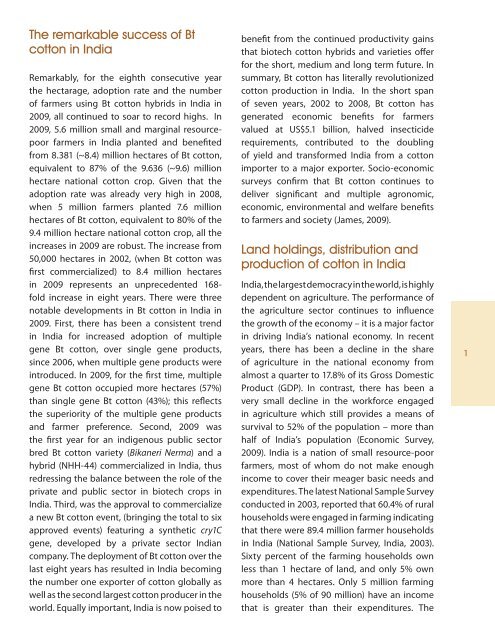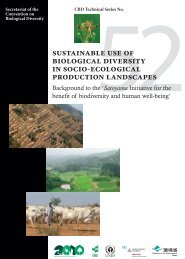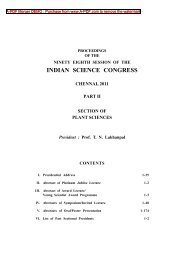A COUNTRY PROFILE Bt CoËon In India - India Environment Portal
A COUNTRY PROFILE Bt CoËon In India - India Environment Portal
A COUNTRY PROFILE Bt CoËon In India - India Environment Portal
You also want an ePaper? Increase the reach of your titles
YUMPU automatically turns print PDFs into web optimized ePapers that Google loves.
The remarkable success of <strong>Bt</strong><br />
cotton in <strong>In</strong>dia<br />
Remarkably, for the eighth consecutive year<br />
the hectarage, adoption rate and the number<br />
of farmers using <strong>Bt</strong> cotton hybrids in <strong>In</strong>dia in<br />
2009, all continued to soar to record highs. <strong>In</strong><br />
2009, 5.6 million small and marginal resourcepoor<br />
farmers in <strong>In</strong>dia planted and benefited<br />
from 8.381 (~8.4) million hectares of <strong>Bt</strong> cotton,<br />
equivalent to 87% of the 9.636 (~9.6) million<br />
hectare national cotton crop. Given that the<br />
adoption rate was already very high in 2008,<br />
when 5 million farmers planted 7.6 million<br />
hectares of <strong>Bt</strong> cotton, equivalent to 80% of the<br />
9.4 million hectare national cotton crop, all the<br />
increases in 2009 are robust. The increase from<br />
50,000 hectares in 2002, (when <strong>Bt</strong> cotton was<br />
first commercialized) to 8.4 million hectares<br />
in 2009 represents an unprecedented 168-<br />
fold increase in eight years. There were three<br />
notable developments in <strong>Bt</strong> cotton in <strong>In</strong>dia in<br />
2009. First, there has been a consistent trend<br />
in <strong>In</strong>dia for increased adoption of multiple<br />
gene <strong>Bt</strong> cotton, over single gene products,<br />
since 2006, when multiple gene products were<br />
introduced. <strong>In</strong> 2009, for the first time, multiple<br />
gene <strong>Bt</strong> cotton occupied more hectares (57%)<br />
than single gene <strong>Bt</strong> cotton (43%); this reflects<br />
the superiority of the multiple gene products<br />
and farmer preference. Second, 2009 was<br />
the first year for an indigenous public sector<br />
bred <strong>Bt</strong> cotton variety (Bikaneri Nerma) and a<br />
hybrid (NHH-44) commercialized in <strong>In</strong>dia, thus<br />
redressing the balance between the role of the<br />
private and public sector in biotech crops in<br />
<strong>In</strong>dia. Third, was the approval to commercialize<br />
a new <strong>Bt</strong> cotton event, (bringing the total to six<br />
approved events) featuring a synthetic cry1C<br />
gene, developed by a private sector <strong>In</strong>dian<br />
company. The deployment of <strong>Bt</strong> cotton over the<br />
last eight years has resulted in <strong>In</strong>dia becoming<br />
the number one exporter of cotton globally as<br />
well as the second largest cotton producer in the<br />
world. Equally important, <strong>In</strong>dia is now poised to<br />
benefit from the continued productivity gains<br />
that biotech cotton hybrids and varieties offer<br />
for the short, medium and long term future. <strong>In</strong><br />
summary, <strong>Bt</strong> cotton has literally revolutionized<br />
cotton production in <strong>In</strong>dia. <strong>In</strong> the short span<br />
of seven years, 2002 to 2008, <strong>Bt</strong> cotton has<br />
generated economic benefits for farmers<br />
valued at US$5.1 billion, halved insecticide<br />
requirements, contributed to the doubling<br />
of yield and transformed <strong>In</strong>dia from a cotton<br />
importer to a major exporter. Socio-economic<br />
surveys confirm that <strong>Bt</strong> cotton continues to<br />
deliver significant and multiple agronomic,<br />
economic, environmental and welfare benefits<br />
to farmers and society (James, 2009).<br />
Land holdings, distribution and<br />
production of cotton in <strong>In</strong>dia<br />
<strong>In</strong>dia, the largest democracy in the world, is highly<br />
dependent on agriculture. The performance of<br />
the agriculture sector continues to influence<br />
the growth of the economy – it is a major factor<br />
in driving <strong>In</strong>dia’s national economy. <strong>In</strong> recent<br />
years, there has been a decline in the share<br />
of agriculture in the national economy from<br />
almost a quarter to 17.8% of its Gross Domestic<br />
Product (GDP). <strong>In</strong> contrast, there has been a<br />
very small decline in the workforce engaged<br />
in agriculture which still provides a means of<br />
survival to 52% of the population – more than<br />
half of <strong>In</strong>dia’s population (Economic Survey,<br />
2009). <strong>In</strong>dia is a nation of small resource-poor<br />
farmers, most of whom do not make enough<br />
income to cover their meager basic needs and<br />
expenditures. The latest National Sample Survey<br />
conducted in 2003, reported that 60.4% of rural<br />
households were engaged in farming indicating<br />
that there were 89.4 million farmer households<br />
in <strong>In</strong>dia (National Sample Survey, <strong>In</strong>dia, 2003).<br />
Sixty percent of the farming households own<br />
less than 1 hectare of land, and only 5% own<br />
more than 4 hectares. Only 5 million farming<br />
households (5% of 90 million) have an income<br />
that is greater than their expenditures. The<br />
1

















